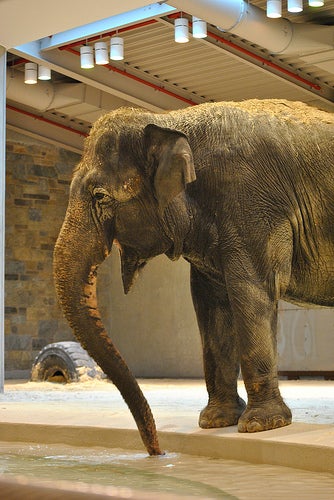Smithsonian's National Zoo Opens New Home for Asian Elephants
Elephant Trails Highlights Animal Care, Breeding and Conservation
The commitment at the National Zoo to save Asian elephants from extinction and ensure a future for this endangered species spans more than 50 years. In keeping with the best practices for elephant management, the Zoo has invested in a state-of-the-art exhibit: Elephant Trails. This innovative and expanded home will enable the Zoo to provide the best possible care for its elephants: females Ambika, 65, and Shanthi, 38, and Shanthi's 11-year-old male offspring, Kandula. The public opening of the Elephant Community Center March 23 at noon marks the completion of Elephant Trails, which was a seven-year, $56 million project.
As a leader in Asian elephant care, management and research, the National Zoo has already made great strides in conserving these magnificent creatures, said Zoo Director Dennis Kelly. Elephant Trails goes above and beyond these investments. We've maximized space for our animals to roam, maximized our ability to administer care and maximized the connection visitors can make with our herd.
Elephant Trails invites visitors to experience the sights, sounds and smells of being close to the Zoo's Asian elephants. In addition, the interactive exhibits teach visitors about elephants' physical characteristics, social behaviors, intelligence and the commitment it takes to care for them.
Every day our elephants become more comfortable in their new surroundings, said Tony Barthel, curator of Elephant Trails. We hope our visitors' experience with Ambika, Shanthi and Kandula helps them feel connected to the Zoo's herd and inspires them to help protect Asian elephants in the wild.
The Elephant Community Center was built within the walls of the Zoo's historic 1930s Elephant House. The renovated indoor exhibit provides the Zoo's elephants with space for socializing, training and playing while providing the elephant staff a safe and well-designed facility to access the animals and administer excellent care. In keeping with the Zoo's conservation mission, both the Elephant Community Center and Elephant Barn use environmentally friendly elements such as geothermal wells, operable skylights and on-site water filtration, among others. The buildings were designed to meet the Leadership in Energy and Environmental Design Gold standards. LEED certification takes place about six months after the exhibit opens.
In order to ensure the Zoo's elephants had ample room both indoors and outdoors, design firm VITETTA and Zoo staff consulted scientific studies that looked at the amount of space wild Asian elephants use on a daily basis. Altogether, Elephant Trails contains 29,333 square feet (8,943 square meters) of elephant space, which is large enough to house between eight and 10 adult Asian elephants and their young. From an animal management perspective, it can accommodate up to three separate groups of elephants, including a matriarchal herd and individual bulls. The indoor exhibit is 4,041 square feet (1,232 square meters); the outdoor exhibit is 25,292 square feet (7,711 square meters).
The Zoo built Elephant Trails to best manage and care for its elephants. The facility includes living space covered in substrates that are gentle on the elephants' feet, such as sand, rubber and dirt. Elephant Trails also facilitates enrichment opportunities that stimulate the animals mentally and physically. Permanent exhibit enrichment includes elevated terrain, pools and sand piles that encourage the animals to exercise, forage and socialize. In addition, keepers can introduce novel objects like scratch trees, tractor tires and boomer balls to stimulate the elephants' curiosity.
Elephant Trails also highlights 50 years of Smithsonian Conservation Biology Institute elephant research—both at the National Zoo and in native habitats. The Zoo's National Elephant Herpesvirus Laboratory is the principal resource for herpesvirus information, testing and research for the global elephant community. In addition, SCBI's Endocrine Research Lab is the only facility in the United States providing extensive monitoring services for tracking the reproductive health of zoo elephants. The findings from these kinds of research projects are applied to wild Asian elephant conservation efforts and to captive management of elephants in zoos.
For additional information about Elephant Trails, visit the online press kit, which includes Frequently Asked Questions, Caring for the Elephants, LEED Standards, Meet the Zoo's Elephants, Elephant Facts and Science Overview.

